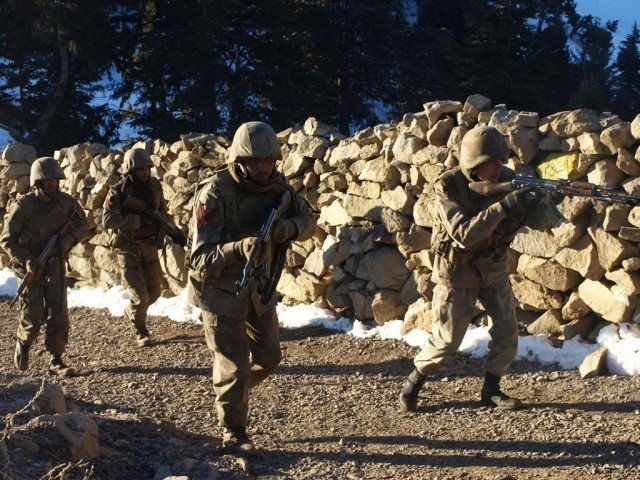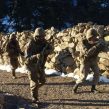
The Successes and Failures of Pakistan’s Operation Zarb-e-Azb
Publication: Terrorism Monitor Volume: 13 Issue: 14
By:

On June 15, the ongoing Pakistan Army operation “Operation Zarb-e-Azb” (Sharp Strike) completed its first year. The military operation is the first of its kind against the Islamist insurgents based in the North Waziristan district of the Federally Administered Tribal Areas (FATA) of Pakistan. However, there have been previous operations elsewhere in FATA since Pakistan’s first operation against al-Qaeda, Tehrik-e-Taliban Pakistan (TTP) and other foreign Islamist militant groups in the area in 2002. The current operation is intended to target al-Qaeda and its associated movements, both foreign and domestic, including the Islamic Movement of Uzbekistan (IMU), the Chechen Islamic Jihad Union (IJU) and Emirate-e-Kaukav, as well as the East Turkistan Islamic Movement (ETIM) and other various factions of the TTP. [1]
The semi-autonomous FATA comprises seven districts (a.k.a. agencies), and North Waziristan is known for its rugged and rough terrain and inhospitable environment. Previous major military operations conducted in FATA’s six other districts were Operation al-Mizan, Operation Zalzala, Operation Sher Dil, Operation Rah-e-Rast, Operation Rah-e-Haq and Operation Rah-e-Nijat. Despite some achievements, however, most of these operations were not fully successful. For years, consecutive Pakistani governments and military authorities avoided opening a new front against entrenched Islamist militants in North Waziristan, despite coming under intense pressure from the United States and other Western governments as many international terrorist plots had their origins in North Waziristan, particularly in camps associated with al-Qaeda and the TTP.
An example of this reluctance to enter North Waziristan came after Operation Rah-e-Nijat, the last major operation launched by Pakistan Army against the Islamist militants in FATA in 2009. This operation targeted TTP-controlled areas in South Waziristan. In 2011, the then Chief of Army Staff, General Ashfaq Pervez Kayani, was urged by the international community to also pursue on-the-run Islamist militants seeking refuge in North Waziristan. Lieutenant General Asif Yasin Malik, however, who was supervising operations in the area, told a group of reporters the same year: “We will undertake operations in North Waziristan when we want to… We will undertake such an operation when it is in our national interest militarily” (Dawn, June 1, 2011). The army also repeatedly said that it was overstretched and could not maintain its supply lines if it had expanded its military operation into North Waziristan.
Launching the Operation
The North Waziristan operation, after much ado, was finally launched on June 15, 2014, after it became clear to the government of Prime Minister Nawaz Sharif that the peace talks with the TTP were nowhere close to fruition, and that, despite the talks, the TTP had been conducting attacks in Pakistani cities. The Pakistani Army was also getting edgy as more and more military installations had been targeted by the TTP; in one particular strike, Lieutenant General Sanaullah Niazi, a three-star general involved in previous military operations against the TTP, had been assassinated by the group in Khyber Pakhtunkhwa province near the Afghan border (News International, September 16, 2013). Another key event that triggered the military was the TTP’s beheading of 23 captured soldiers from Pakistan’s Frontier Corps in February 2014 (Dawn, February 18, 2014). The TTP further provoked the military by using Islamic Movement of Uzbekistan (IMU) members to conduct an attack at the Jinnah International Terminal of Karachi Airport, which resulted in the killing of 28 airport security personnel (Dawn, June 9, 2014). Following the government’s decision to take the offensive, the military launched airstrikes, and 30,000 troops marched into North Waziristan, where operations have since continued up to the present day.
Evaluating Success
Even after a year, it is difficult to gauge the success of Zarb-e-Azb, largely because figures provided to the public come from only one source, Inter-Services Public Relations (ISPR) of the Pakistani Army. There is no other reliable source of facts, and no independent media organization was allowed to embed with the army units fighting the Islamist militants in North Waziristan during the whole past year (aside from occasional tours organized by ISPR for select groups of journalists to show destroyed militant hideouts and captured weapons). That said, according to the official sources, the operation is a great success. For instance, according to the ISPR statement issued on the operation’s first anniversary, the military has destroyed 837 militant hideouts in North Waziristan, recovered and destroyed 253 tons of explosives, captured 18,087 weapons, conducted 9,000 intelligence-based operations and killed 2,763 militants, at the cost of losing 347 officers and soldiers (Express Tribune, June 15).
In addition to the official figures, it seems that the operation has brought comparative peace and tranquility to Pakistani cities, which were previously under an intense militant threat, particularly in FATA. For instance, the total number of fatalities in FATA stood at 2,863 during the year 2014, whereas the fatalities from the first three months of 2015 stood at 411, a pro rata reduction of around a third. [2] As far as the operation’s financial costs, Pakistani Minister of Finance Ishaq Dar has said the operation may cost around $1.3 billion (Geo News, February 19).
One weakness of the operation has been the government’s neglect to coordinate it with the government of neighboring Afghanistan. As a result, just as in many previous military operations when Islamist militants escaped by fleeing into North Waziristan district, this time they have sneaked into the relative safety of Afghanistan. For instance, according to one local news report, “at least 400 families affiliated with militant groups—including members of al-Qaeda and the Islamic Movement of Uzbekistan—crossed into Afghanistan in December and now live in the homes of locals in lawless parts of the country” (Express Tribune, January 30).
Conclusion
Operation Zarb-e-Azb was long overdue, not least because North Waziristan’s existence as a safe haven for militants persistently hampered the success of other military operations during 2002-2014. Indeed, militants’ ability to rapidly find refuge in North Waziristan to regroup and regain their lost momentum is a major reason that Pakistan’s major operations failed to achieve their set targets over the last decade. The present operation has so far managed to bring considerable calm to Pakistani cities, but nonetheless, the TTP and affiliated group are still able to launch major attacks. One large retaliatory suicide bombing was launched at Pakistan-India border crossing near Wagah, Lahore, on November 2, 2014. This attack cost the lives of 55 people and injured 200 others. The attack was claimed by Jamaat ul-Ahrar, one of the Islamist groups that is a part of the TTP cluster. In addition, another TTP faction led by Mullah Fazlullah perpetrated a terrorist attack at the Army Public School in Peshawar on December 16, 2014. This attack, termed “Pakistan’s 9/11,” claimed lives of 142 people, 132 of whom were school children. An additional risk arising from Operation Zarb-e-Azb is that adjacent Afghan provinces could now become a “new North Waziristan” as Islamist militants pushed out by Zarb-e-Azb have taken refuge there, underlining the problems caused by Pakistan’s failure to get the Afghan government of President Ashraf Ghani on board before launching the operation. This lack of Afghanistan-Pakistan cooperation, and the resulting militant safe havens into Afghanistan, is likely to be one reason why no major Islamist militant leader, such as Fazlullah, Adnan Rashid, Omar Khalid Khorasani and Hafiz Gul Bahadur, has so far been killed or captured during the operation.
Farhan Zahid writes on counter-terrorism, al-Qaeda, Pakistani al-Qaeda-linked groups, Islamist violent non-state actors in Pakistan, militant landscapes in Pakistan and the Afghan Taliban.
Notes
1. Al-Qaeda and the TTP have a network of Islamist militant groups based in mainland Pakistan (four provinces and Islamabad Capital Territory), commonly known as “Punjabi Taliban.” These groups are proscribed organizations under Pakistani laws, but still manage to operate under different names. Some of these include Harkat ul-Jihad-e-Islami (HuJI), Harkat ul-Mujahideen (HuM), Lashkar-e-Jhangvi (LeJ), Jaysh-e-Muhammad (JeM) and Lashkar-e-Taiba (LeT).
2. South Asia Terrorism Portal, “FATA Assessment 2015,” https://www.satp.org/satporgtp/countries/pakistan/Waziristan/index.html.





